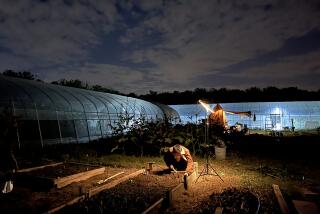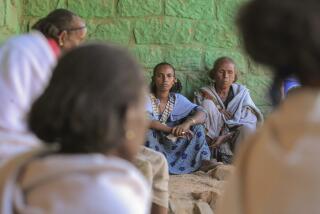Food crisis yields an African opportunity
NYAMATA, RWANDA â When he was a boy, Charles Munyaweraâs parents abandoned the Rwandan countryside in search of richer opportunities in Kigali, the capital city.
Now the 62-year-old entrepreneur is heading back to this nationâs agricultural heartland, lured by a worldwide food crisis that is turning a backbreaking and often-unprofitable way of life into what may be one of the hottest opportunities around.
Munyawera recently invested $300 as one of about 140 participants in a farming cooperative that expects to reap its first corn harvest this summer. Although the cooperative remains untested in many ways, heâs already lined up buyers and expects prices to be 35% higher than just six months ago.
âDemand is huge,â Munyawera said, beaming.
In Africa, a place all too familiar with chronic malnutrition and recurring famines, the international food crisis is playing out in some surprising ways.
Soaring prices are pummeling urban dwellers who rely on imported food and often earn less than $2 a day. Riots have already rocked Somalia and Cameroon.
But in rural areas, home to most Africans, small farmers live largely on what they grow. The food crisis could be a boon for such farmers, who depend far more on last seasonâs rainfall and the condition of local roads than on crude oil prices.
As governments focus on reducing their dependency on imports, small farmers are poised to receive some overdue assistance. And rising prices will mean farmers have incentives to plant more after decades of productivity declining under the weight of poverty, foreign competition and a marketplace flooded with subsidized food.
âThis might be one of the best opportunities that poor subsistence-level farmers will ever have to claw their way out of poverty,â said Josh Ruxin, founder of Access Project Rwanda, an anti-poverty advocacy group. âFor the first time in years, they might be able to make some money.â
Roots of the current food crisis are global: growing demand for meat in China and India, diversion of U.S. corn for ethanol, record oil prices and an Australian drought.
Helping African farmers help themselves will be far cheaper for the international community than a more drastic measure such as an emergency bailout, said Pedro Sanchez, director of tropical agriculture at Columbia Universityâs Earth Institute, a poverty research and advocacy group.
Sanchez said that just $70 worth of basic assistance, such as better seeds and fertilizer, would enable the average African farmer to grow an additional ton of corn. Delivering the same amount of corn as emergency aid would cost $700, he said.
Nevertheless, international donors, the World Bank and most African governments for decades have largely ignored the needs of farmers, despite the fact that agriculture is the continentâs largest economic sector and biggest employer.
Growers of African staples such as corn, sorghum, which provides grain and syrup, and cassava, which has starchy roots used as a vegetable and for bread flour, still farm much as their ancestors did. They till the soil by hand, use of fertilizer is uncommon, and less than 5% of arable land is irrigated.
Rather than high-quality, improved seeds, many farmers in Africa use leftovers from previous harvests. Without proper storage facilities, they must sell their harvest twice a year during the high season after the rains, when prices are lowest.
Agricultural productivity fell in Africa during the last 50 years, even as it grew everywhere else. Average crop yields are one-quarter to one-third of those in Asia.
âAfrica is the only region where farmers canât even feed themselves,â said A. Namanga Ngongi, president of the Alliance for a Green Revolution in Africa, an agriculture research group based in Nairobi, Kenya.
In Rwanda, the statistics are even more disheartening, despite the fact that subsistence farmers constitute 80% of the population: Less than 1% of the farmland is irrigated. The average plot size is about five acres.
The picturesque countryside is so lush and the soil so rich that it would seem anything would grow. Yet productivity has dropped 20% since 1990, according to the World Food Program.
âFarming was easier for my parents,â said 35-year-old Clementine Bazibagira, dwarfed by green stalks of corn and sorghum as she tended to her plot in Nyamata, a bucolic farming town in central Rwanda that became a tinderbox in the 1994 genocide.
Bazibagira, a single mother, said she and her four children eat most of what she grows but hope for a small surplus to sell to raise cash for school fees, salt and soap.
Her parents had owned much of the surrounding area, but the land was sold off and divided among other family members, leaving her with just two acres. Her father had animals, which provided manure for fertilizer. But she canât afford either. Her only tool is a wood-handled hoe.
âThe land was more fertile back then,â she said.
Munyawera, the businessman, saw the opportunity to make good returns even with a modest investment in modernization.
Farmers provided the land in his cooperative and investors put up cash for fertilizer, seeds, pesticide and other expenses. They expect to boost production sevenfold in one season and split the profit evenly.
Before the cooperative began, the same group of farmers produced less than half a ton of corn per hectare, almost 2 1/2 acres. The new harvest is expected to yield 3 1/2 tons per hectare.
âWe need to change the way farmers operate,â Munyawera said.
To do so, many of those eager to increase productivity are looking for much greater government investments.
One of the best examples of government-led agricultural reform is the nation of Malawi, which went from needing food aid in 2005 to exporting grains this year, thanks largely to government subsidies for fertilizer.
Kenya created a government purchasing board to buy corn in the open market at a minimum price, guaranteeing small farmers an outlet for their product at a fair return.
Ethiopia in April launched a food commodity trading exchange to help farmers hedge against bad harvests and droughts.
âOne of the causes of the worldâs food crisis is that we have not invested enough in agriculture,â said Christopher Bazivamo, Rwandaâs minister of agriculture.
In Rwanda, the message sank in during a government retreat in March when leaders learned that the agriculture sector, which accounts for more a third of the countryâs gross domestic product, had stagnated with an average annual growth of 0% during the last five years. In 2007, it dropped 1.2%.
The Agriculture Ministryâs budget got a 27% increase, and the government is looking for ways to assist farmers, focusing first on funding irrigation schemes and addressing soil erosion, a key problem for the mountainous country. Officials are encouraging farmers to form cooperatives to increase their bargaining power, gain access to capital and foster increased production.
âWe want to grow, grow, grow,â said Ernest Ruzindaza, the ministryâs director of planning.
The government is disseminating price data in 42 districts to help inform farmers about market prices so they wonât be exploited by traders.
And like other governments, Rwanda is preparing to offer loans or subsidies for fertilizer and seeds.
At a cooperative in the village of Mayange, farmers plan to focus on specialty crops, including pomegranates and chickpeas.
âWeâre targeting the overseas market,â said Delphin Muhizi, business development coordinator for Millennium Villages Project, which is assisting the cooperative. âA glass of pomegranate juice in the U.S. sells for $10.â
Theyâll face a variety of challenges, including whether the untested crops will grow in Rwanda and how to get harvests from Rwandaâs countryside to foreign buyers. In addition, the cooperative has about 75 acres of hard-packed grazing land that needs to be prepared for planting.
On a recent afternoon, a line of about 20 laborers hammered the dirt with hoes as a portable radio provided some scratchy rhythms to help pass the time. It was slow going. Since October, they had cultivated only about 12 acres.
A tractor could finish the job in a day. But after weeks of searching, they found only one available tractor operator, whose $800 fee was four times what the cooperative could afford.
âItâs a pity,â cooperative manager Eugene Ndakengerwa said. âWe need to plant. But weâll just hire more workers. Weâll get it done.â
--
More to Read
Sign up for Essential California
The most important California stories and recommendations in your inbox every morning.
You may occasionally receive promotional content from the Los Angeles Times.










